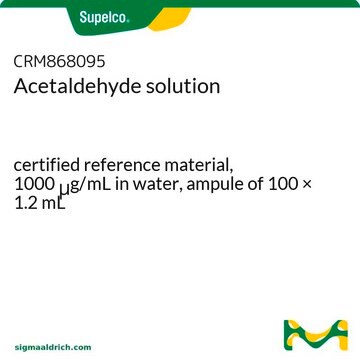W200379
Acetaldehído solution
40 wt. % in H2O
About This Item
Productos recomendados
biological source
synthetic
Quality Level
reg. compliance
FDA 21 CFR 177.2410
FDA 21 CFR 182.60
form
liquid
concentration
35.00-45.00% (titration by hydroxylamine)
40 wt. % in H2O
refractive index
n20/D 1.3771
density
0.868 g/mL at 20 °C
application(s)
flavors and fragrances
documentation
see Safety & Documentation for available documents
food allergen
no known allergens
organoleptic
ethereal
SMILES string
[H]C(C)=O
InChI
1S/C2H4O/c1-2-3/h2H,1H3
InChI key
IKHGUXGNUITLKF-UHFFFAOYSA-N
¿Está buscando productos similares? Visita Guía de comparación de productos
Categorías relacionadas
Disclaimer
comparable product
signalword
Danger
hcodes
Hazard Classifications
Carc. 1B - Eye Irrit. 2 - Flam. Liq. 2 - Muta. 2 - STOT SE 3
target_organs
Respiratory system
Storage Class
3 - Flammable liquids
wgk_germany
WGK 3
flash_point_f
<-0.0 °F - closed cup
flash_point_c
< -17.78 °C - closed cup
ppe
Eyeshields, Faceshields, Gloves, type ABEK (EN14387) respirator filter
Elija entre una de las versiones más recientes:
¿Ya tiene este producto?
Encuentre la documentación para los productos que ha comprado recientemente en la Biblioteca de documentos.
Los clientes también vieron
Artículos
This paper provides an example of a hard-to-handle material and a look into the role of a packaging engineer.
Global Trade Item Number
| Número de referencia del producto (SKU) | GTIN |
|---|---|
| W200379-1KG | 4061838256508 |
| W200379-SAMPLE | 4061838248886 |
Nuestro equipo de científicos tiene experiencia en todas las áreas de investigación: Ciencias de la vida, Ciencia de los materiales, Síntesis química, Cromatografía, Analítica y muchas otras.
Póngase en contacto con el Servicio técnico




